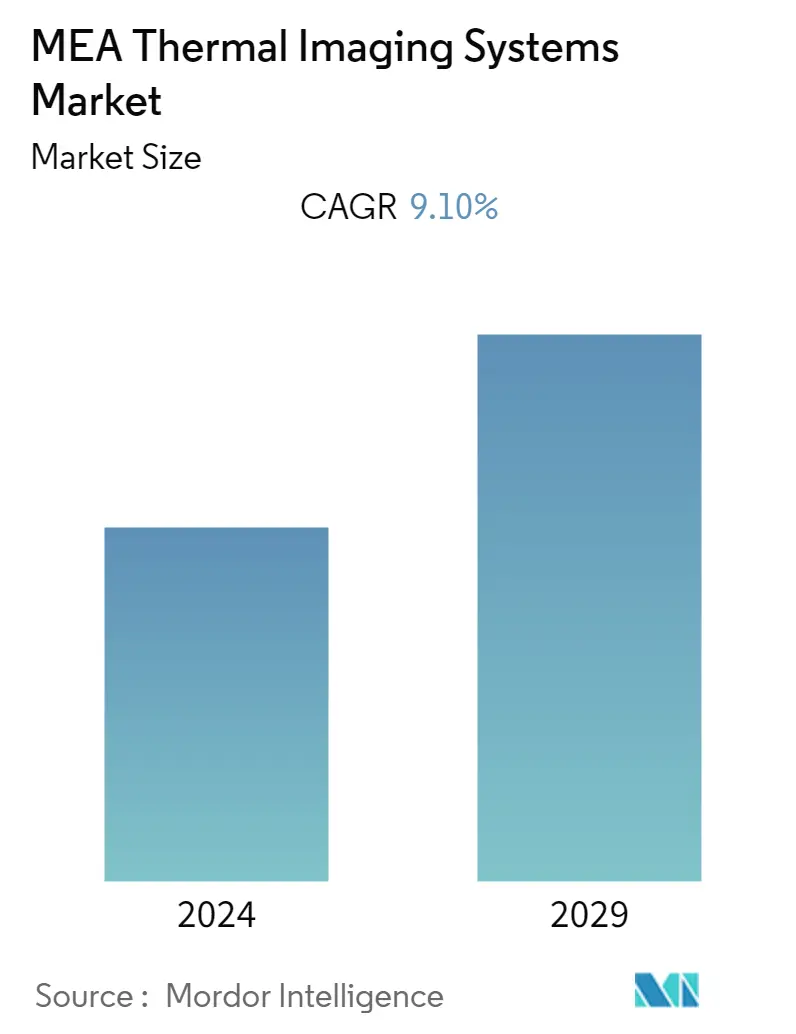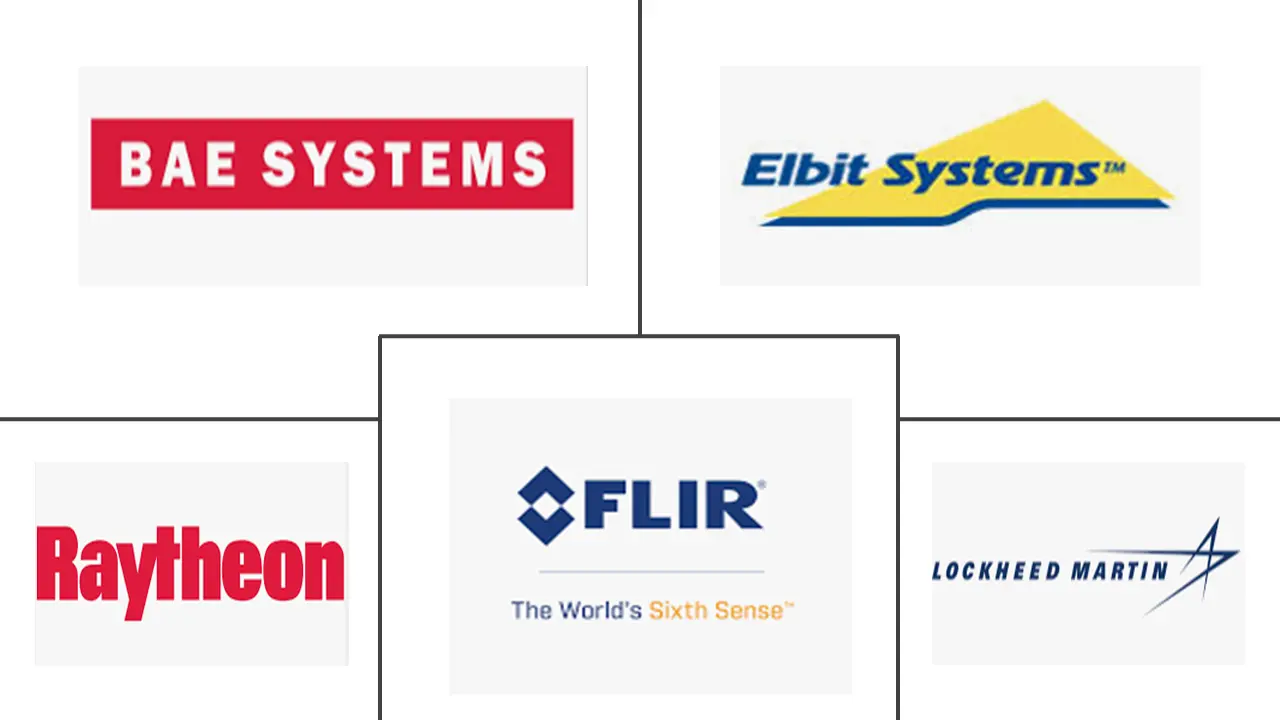Market Size of MEA Thermal Imaging Systems Industry

| Study Period | 2019 - 2029 |
| Base Year For Estimation | 2023 |
| Forecast Data Period | 2024 - 2029 |
| Historical Data Period | 2019 - 2022 |
| CAGR | 9.10 % |
| Market Concentration | Medium |
Major Players
*Disclaimer: Major Players sorted in no particular order |
Middle East and Africa Thermal Imaging Systems Market Analysis
The Middle East and Africa Thermal Imaging Systems market are expected to register a CAGR of 9.1% over the forecast period. The market is expected to grow steadily due to the increased thermal camera usage across various industries, including Aerospace and Defense, Automotive, Healthcare and Life Sciences, Oil and Gas, Food and Beverages, and others.
- In the Middle East and Africa, there is a lot of conflict between ISIS, Al-Qaeda, Al-Shabaab, Boko Haram, and other terrorist groups. In both Africa and the Middle East, there is always geopolitical upheaval. The Middle East is a significant buyer of military hardware. Thermal imaging technology aids the military forces in the region in their war against rebels and terrorists in the region's rough terrains. Recently, Qatar's military spent USD 11.6 billion, making it the fifth largest spender in the Middle East.
- Furthermore, the growing applications of thermal cameras, such as rescue operations, crime investigation, road safety, and so on, have boosted the overall market growth. Thermal cameras can also help firefighters locate hotspots and see through smoke, which can help prevent catastrophic accidents. Furthermore, the growing preference for Advanced Driver-Assistance Systems and rising demand for wireless temperature sensors drive the studied market growth.
- For instance, in February this year, UAE-based Teledyne FLIR announced the launch of the FLIR Cx5, a new pocket-portable thermal camera for condition monitoring in hazardous environments. The FLIR Cx5 has a robust ATEX-compliant case, which authorizes users of this camera to monitor electrical or mechanical assets in hot working zones safely.
- According to the new military strategy, the Saudi Arabian armed forces will modernize their military capabilities by acquiring high-tech and effective weapon systems that provide them with military superiority. To protect Saudi Arabia against internal threats such as extremism and terrorism, the Saudi Arabian Defense Doctrine (SDD) outlines several goals to enhance its military structure and capabilities. Further, the government of the Kingdom plans to increase the local military equipment spending to 50% by 2030. Such developments by governments in the region are anticipated to drive the growth of the market during the forecast period.
- Increased demand for IR cameras is driven by factors such as the growing need for surveillance across various industries, the continual reduction of thermal camera costs, and the rapid development of high-speed infrared cameras. Inaccurate measurements and picture color problems associated with cameras, on the other hand, pose a threat to the industry's growth. The military and defense industries, as well as vehicles, rely heavily on infrared cameras.
- COVID-19's breakout and spread have caused a halt in the region's economic development. It has harmed several sectors, including thermal imaging. Companies were preparing and trying to keep their operations running. The primary obstacles that businesses encounter are product manufacturing and distribution. To restrict the spread of the epidemic, some nations worldwide have implemented or extended lockdowns, causing interruptions in the thermal imaging market's supply chain. Furthermore, the market is expected to grow in the forecast period as various industries such as Automotive, Aerospace and Defense, and many others are proliferating in the region.
Middle East and Africa Thermal Imaging Systems Industry Segmentation
Thermal Imaging Technology enables users to detect objects or individuals in complete darkness and difficult and distinct conditions. Unlike the other methods, thermal imaging works in environments without ambient light. Like near-infrared illumination, thermal imaging can penetrate obscurants like smoke, fog, and haze. The studied market is segmented by various solutions such as Hardware, Software, and Services among Fixed and Handheld Thermal Cameras product types in multiple applications such as Security and Surveillance, Monitoring and Inspection, Detection, and Measurement. Further, the market is also segmented by different end-users, such as Aerospace and Defense, Automotive, Healthcare and Life Sciences, Oil and Gas, and Food and Beverages among multiple countries. The market sizes and forecasts are provided in terms of value (USD million) for all the above segments. The impact of Covid-19 on the market and impacted segments are also covered under the scope of the study. Further, the disruption of the factors affecting the market's expansion in the near future has been covered in the study regarding drivers and restraints. The market sizes and forecasts are provided in terms of value (USD million) for all the above segments.
| By Solutions | |
| Hardware | |
| Software | |
| Services |
| By Product Type | |
| Fixed Thermal Cameras | |
| Handheld Thermal Cameras |
| By Application | |
| Security and Surveillance | |
| Monitoring and Inspection | |
| Detection and Measurement |
| By End-user | |
| Aerospace and Defense | |
| Automotive | |
| Healthcare and Life Sciences | |
| Oil and Gas | |
| Food and Beverages | |
| Others |
| By Country | |
| Saudi Arabia | |
| United Arab Emirates | |
| Rest of Middle East and Africa |
MEA Thermal Imaging Systems Market Size Summary
The Middle East and Africa Thermal Imaging Systems market is poised for significant growth, driven by the increasing adoption of thermal cameras across diverse sectors such as Aerospace and Defense, Automotive, Healthcare, and Oil and Gas. The region's geopolitical tensions and the need for advanced surveillance and security solutions have propelled the demand for thermal imaging technology, particularly in military applications. Governments in the region are investing heavily in modernizing their military capabilities, which includes the acquisition of high-tech thermal imaging systems to enhance operational efficiency and security. Additionally, the automotive industry's shift towards Advanced Driver-Assistance Systems (ADAS) and the rising demand for wireless temperature sensors are further fueling market expansion.
The market landscape is characterized by a mix of established players and emerging companies, all vying to capture market share through innovative solutions and strategic partnerships. The ongoing development of high-speed infrared cameras and the reduction in thermal camera costs are making these technologies more accessible across various industries. Despite challenges posed by the COVID-19 pandemic, which disrupted supply chains and affected economic activities, the market is expected to recover and grow as industries such as Automotive and Aerospace continue to expand. The introduction of new products, like Teledyne FLIR's FLIR Cx5 and OmniVision's Nyxel technology, underscores the industry's commitment to innovation and meeting the evolving needs of end-users.
MEA Thermal Imaging Systems Market Size - Table of Contents
-
1. MARKET INSIGHTS
-
1.1 Market Overview
-
1.2 Value Chain Analysis
-
1.3 Industry Attractiveness - Porter's Five Forces Analysis
-
1.3.1 Threat of New Entrants
-
1.3.2 Bargaining Power of Buyers
-
1.3.3 Bargaining Power of Suppliers
-
1.3.4 Threat of Substitute Products
-
1.3.5 Intensity of Competitive Rivalry
-
-
1.4 Assessment of COVID-19 Impact on the Industry
-
-
2. MARKET SEGMENTATION
-
2.1 By Solutions
-
2.1.1 Hardware
-
2.1.2 Software
-
2.1.3 Services
-
-
2.2 By Product Type
-
2.2.1 Fixed Thermal Cameras
-
2.2.2 Handheld Thermal Cameras
-
-
2.3 By Application
-
2.3.1 Security and Surveillance
-
2.3.2 Monitoring and Inspection
-
2.3.3 Detection and Measurement
-
-
2.4 By End-user
-
2.4.1 Aerospace and Defense
-
2.4.2 Automotive
-
2.4.3 Healthcare and Life Sciences
-
2.4.4 Oil and Gas
-
2.4.5 Food and Beverages
-
2.4.6 Others
-
-
2.5 By Country
-
2.5.1 Saudi Arabia
-
2.5.2 United Arab Emirates
-
2.5.3 Rest of Middle East and Africa
-
-
MEA Thermal Imaging Systems Market Size FAQs
What is the current MEA Thermal Imaging Systems Market size?
The MEA Thermal Imaging Systems Market is projected to register a CAGR of 9.10% during the forecast period (2024-2029)
Who are the key players in MEA Thermal Imaging Systems Market?
Flir Systems, Inc., BAE Systems plc, Elbit Systems Ltd., Raytheon Company and Lockheed Martin Corporation are the major companies operating in the MEA Thermal Imaging Systems Market.

